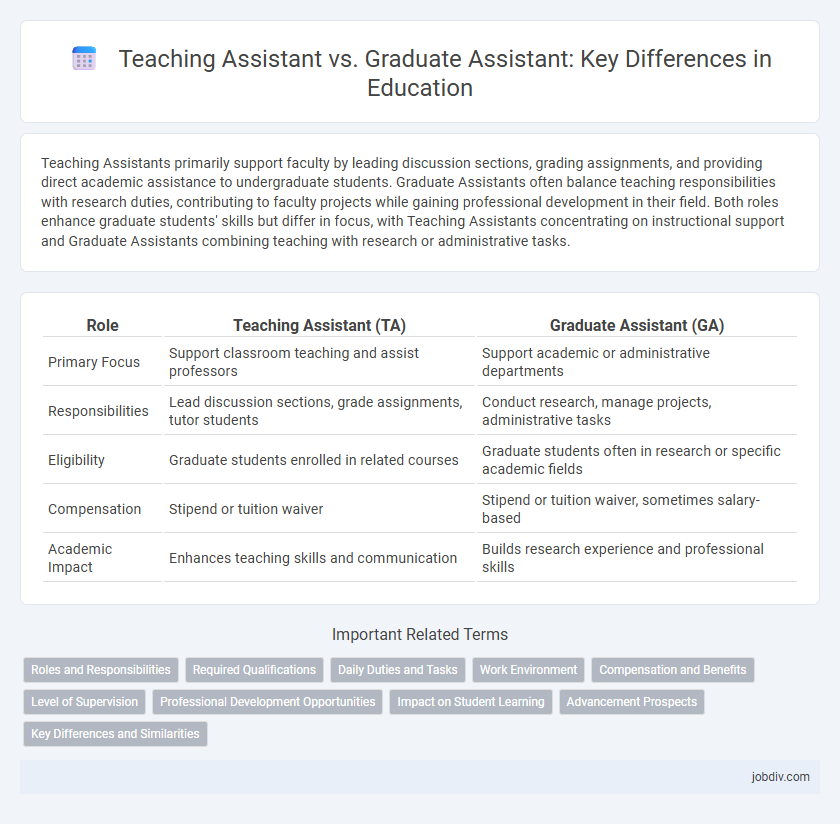Teaching Assistants primarily support faculty by leading discussion sections, grading assignments, and providing direct academic assistance to undergraduate students. Graduate Assistants often balance teaching responsibilities with research duties, contributing to faculty projects while gaining professional development in their field. Both roles enhance graduate students' skills but differ in focus, with Teaching Assistants concentrating on instructional support and Graduate Assistants combining teaching with research or administrative tasks.
Table of Comparison
| Role | Teaching Assistant (TA) | Graduate Assistant (GA) |
|---|---|---|
| Primary Focus | Support classroom teaching and assist professors | Support academic or administrative departments |
| Responsibilities | Lead discussion sections, grade assignments, tutor students | Conduct research, manage projects, administrative tasks |
| Eligibility | Graduate students enrolled in related courses | Graduate students often in research or specific academic fields |
| Compensation | Stipend or tuition waiver | Stipend or tuition waiver, sometimes salary-based |
| Academic Impact | Enhances teaching skills and communication | Builds research experience and professional skills |
Roles and Responsibilities
Teaching Assistants primarily support faculty by leading discussion sections, grading assignments, and providing direct student assistance during office hours, enhancing the learning experience in undergraduate courses. Graduate Assistants often balance research duties alongside teaching responsibilities, contributing to academic projects, conducting literature reviews, and assisting in lab management, with roles varying by department. Both positions require strong communication skills and subject expertise but differ significantly in task emphasis and workload distribution within higher education institutions.
Required Qualifications
Teaching assistants typically require enrollment in a graduate program with subject-specific knowledge and strong communication skills to support instructional activities. Graduate assistants often need a combination of academic achievement in their field of study and research capabilities, sometimes requiring prior teaching or administrative experience. Both roles demand the ability to manage time efficiently and collaborate effectively within the academic environment.
Daily Duties and Tasks
Teaching Assistants primarily support professors by leading discussion sections, grading assignments, and assisting students with coursework. Graduate Assistants often handle a broader range of responsibilities, including conducting research projects, administrative tasks, and occasionally teaching full courses. Both roles require strong communication skills, but Teaching Assistants focus more on student interaction while Graduate Assistants balance academic support with research duties.
Work Environment
Teaching Assistants typically work closely with undergraduate students in classroom or lab settings, supporting professors by leading discussion sections and grading assignments. Graduate Assistants often split their time between research projects and administrative tasks within their academic departments, working in offices or research facilities. The work environment for Teaching Assistants is more student-facing, while Graduate Assistants experience a balance of independent research and collaboration with faculty members.
Compensation and Benefits
Teaching Assistants often receive a stipend that ranges from $15,000 to $25,000 annually, along with tuition waivers and health insurance benefits depending on the institution. Graduate Assistants typically earn higher compensation, averaging $20,000 to $30,000 per year, and may also gain access to professional development funds, more comprehensive health plans, and eligibility for research grants. Both roles usually include tuition remission, but Graduate Assistants generally enjoy a broader spectrum of financial and academic resources.
Level of Supervision
Teaching Assistants operate under moderate supervision, often guided directly by professors to manage classroom activities and provide student support. Graduate Assistants typically experience a higher level of autonomy, tasked with specialized research or administrative duties requiring independent decision-making. The level of supervision varies significantly depending on the institution's policies and specific departmental requirements.
Professional Development Opportunities
Teaching Assistants often gain hands-on experience in classroom management, lesson planning, and direct student engagement, which enhances their instructional skills and pedagogical knowledge. Graduate Assistants typically engage in research projects, administrative tasks, and departmental responsibilities, offering valuable insight into academic operations and scholarly development. Both roles contribute to professional growth, but Teaching Assistants emphasize instructional expertise while Graduate Assistants build research and administrative competencies.
Impact on Student Learning
Teaching Assistants directly enhance student learning by facilitating discussions, grading assignments, and offering personalized academic support, which promotes deeper understanding and engagement. Graduate Assistants contribute by conducting research or assisting faculty with course preparation, indirectly impacting student learning through improved curriculum development. Both roles play crucial parts in fostering an enriched educational environment that supports diverse learner needs.
Advancement Prospects
Teaching Assistants often gain hands-on classroom experience that enhances their instructional skills, making them well-suited for future roles in education or academia. Graduate Assistants typically engage in research, administration, or specialized projects, providing a broader skill set that supports advancement into academic administration or research-intensive careers. Both roles offer valuable professional development, but Graduate Assistant positions may provide greater opportunities for leadership and specialization.
Key Differences and Similarities
Teaching Assistants (TAs) primarily support faculty by leading discussion sections, grading, and providing direct student assistance, while Graduate Assistants (GAs) often have broader roles that may include administrative tasks, research, and project management alongside teaching duties. Both positions typically require enrollment in a graduate program and offer stipends or tuition waivers, but TAs focus more on instructional support whereas GAs can have diverse roles depending on departmental needs. Commonalities include opportunities for professional development, enhanced academic experience, and contributions to the educational environment.
Teaching Assistant vs Graduate Assistant Infographic

 jobdiv.com
jobdiv.com